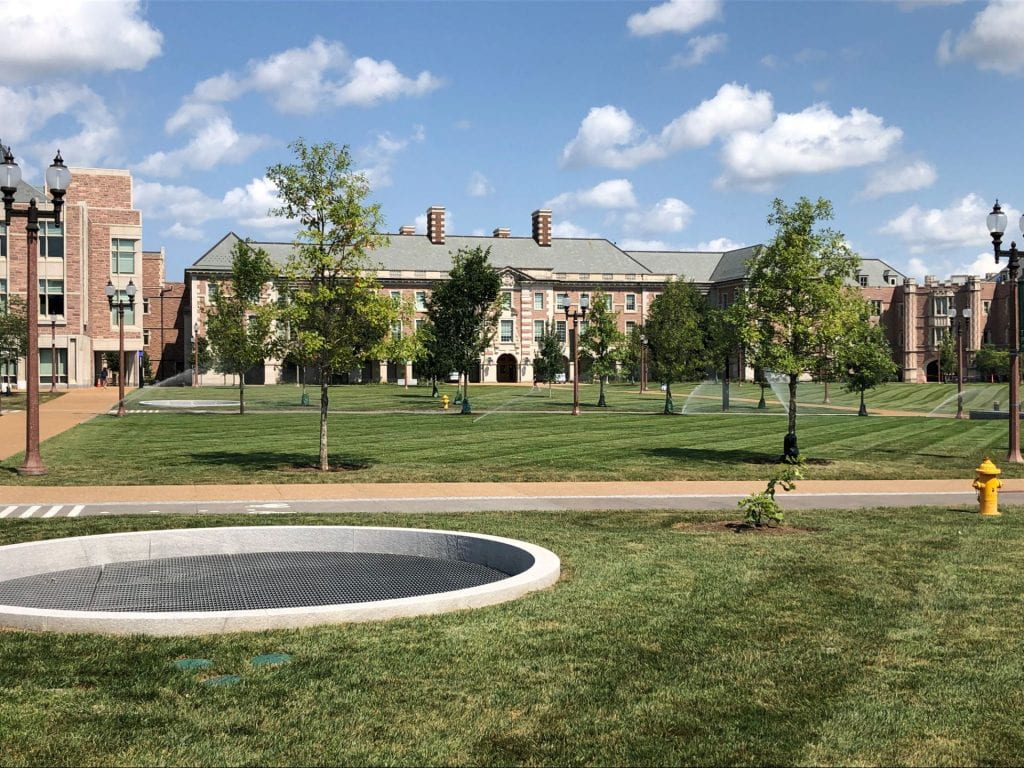By Jarea Fang
The grass is greener where you water it, and that is certainly true of WashU. Danforth Campus, which is known for its park-like landscape and plots of green, uses irrigation to water about two-thirds of its green space. Every year irrigation becomes a familiar sight to WashU eyes, and passersby have long learned to swerve in their paths in order to avoid getting rained on.
According to Cassie Hage, the assistant director of OOS, sprinkler usage on campus is one of the most prominent questions that members of our community bring to our office. While some are concerned with water usage, others want to know about the mechanics.
“There are many assumptions that people have about irrigation and how it operates, which can cause a great deal of questioning, naturally,” says Chris Anderson, the Grounds Manager and Horticulturist at WashU. “But I can confidently say that we manage our irrigation very well and are constantly improving to make it more sustainable.”
Thus, with the help of Chris and Cody Azotea from Focal Pointe, the landscaping professionals who work on WashU’s green spaces, here are some frequently asked questions and their answers:
FAQ #1: Why are the sprinklers on when it is raining?
Although watering while it’s raining might look wasteful, in certain circumstances it’s purposeful. Irrigating just before, during, or after a light rain can help water penetrate the soil at a deeper level, which is more valuable for established plants. Other times, it may genuinely be a wiring problem, as rain sensors on sprinklers can malfunction occasionally just like any other machinery.
That being said, Focal Pointe have upgraded the controllers on Forsyth, Ellenwood, and University Lane to connect via wi-fi with Hydrowise program, which will automatically adjust watering based on internet-sourced local weather data, saving significant amounts of water every day. Other sprinkler controllers on campus will also be connected to the program in the near future.
FAQ #2: Why are the sprinklers on during the heat of the day?
To battle the summer heat, it is very important to do “syringe cycles” during hot days. These short spurts of water will keep the surface of the lawn hydrated when the temperature gets to extreme levels. This is especially true on the East End where plants grow in sand. Extra cycles also run when installing new sod or plant life.
When inspections or repairs are happening, the sprinklers may run at odd times as well, including during the heat of day. Additionally, construction work on campus can also damage wiring, heads, and lines which will cause sprinklers to run at the wrong times or malfunction all together.
FAQ #3: Why do we use sprinklers rather than drip irrigation?
Drip irrigation is a micro-irrigation system that sends small drops of water directly to the roots of plants. While this method of irrigation is effective for conserving water and preserving nutrients in the soil, it is much more suitable for confined green spaces rather than open lawns. The rooftop of Hillman Hall, for example, uses drip irrigation to maintain its gardens, while wider areas on campus use a sprinkler system for greater efficiency.
Additionally, the university has been working for years to convert inefficient spray heads to MP rotator heads, which allows water to gently soak in at rates that soils can absorb. This conversion allows the university to save up to 30% of its past water usage!
